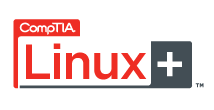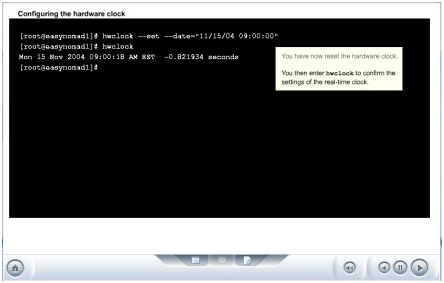
CompTIA's Linux+ is a is a vendor-neutral certification that validates the knowledge of individuals with a minimum of six to twelve months of practical Linux experience. To become certified you must pass the LX0-101 and the LX0-102 certification exams
The CompTIA Linux+ Training Course confirms an IT professional's proficiency in the everyday management of Linux-based clients and basic management of server systems. Students will learn the knowledge and tools necessary to manage Linux systems from the command line, as well as how to manage user administration, file permissions, software configurations, and clients, server systems and security.
Our course follows the CompTIA authorized curriculum, ensuring you receive the training and knowledge needed to succeed. In order to become certified, you need to pass both LX0-101 and LX0-102 exams.
We also offer Linux Boot Classes Nationally
Certification Course includes
Full Multi Media Lessons
Test Preps - Hundred of practice exams
Instructor Mentoring Online 24 x 7
Lab Exercises
CompTIA Linux+ LX0-101 Course Outline
Linux and CLI
- The basic characteristics of the Linux operating system.
- Advantages of the Linux shell and some of the main versions.
- Use shell commands to verify the environment, find information about commands, use shortcuts, and support multitasking.
- Basic shell commands to handle directory and file information.
- Special characters in Linux commands.
- Interact with the shell environment.
- Set the PATH environment variable in a secure way.
- The history facility and edit previously entered commands.
- Some of the advanced facilities of the command line.
- Use the Linux shell to execute commands and manipulate files.
Streams, Pipes, Redirects, and Processes
- Select the correct command redirection approach offered by Linux.
- Issue redirection commands to redirect input and output to and from utilities.
- How Linux manages processes using the ps, bg, and fg commands.
- Select the commands used to manage asynchronous processes in Linux.
- View and change the priority of processes.
- Manage priorities using the Linux shell.
Regular Expressions and Text Processing
- How metacharacters are used in both filename generation and regular expressions.
- Files using the grep command family.
- The sed commands that search through files and make simple changes.
- Search and edits files with grep and sed.
- The key functionality provided by Linux text-processing utilities.
- Linux commands used to filter text.
- Vi commands for editing text.
- The vi commands used to search and replace text.
- The vi commands to manipulate text.
File Handling in Linux
- The main characteristics of the way Linux manages files.
- How to navigate resources in the Linux file system hierarchy.
- The commands used to find files and command locations.
- Files using which, updatedb, locate, and find.
- The commands used to manage hard and symbolic links.
- Commands that set permissions and change attributes on Linux files.
- Commands used to set permissions on files and directories.
- Special permissions SUID, SGID, and sticky bits for files and change the default file creation mode using umask.
- The correct options for the chown and chgrp commands.
File System Mounting and Management
- How to mount Linux file systems.
- Options that configure file systems so that they automatically mount on startup.
- The commands used to mount and unmount file systems manually.
- The appropriate commands and techniques to monitor and manage disk space.
- Check file systems and correct problems.
- Disk free space and check file usage in Linux.
Partitions, File Systems, and Disk Quotas in Linux
- The role of partitions in Linux.
- The commands that create partitions and file systems.
- What disk quotas are and how to view them.
- Command options used to manage user disk quotas.
- The commands used to manage partitions, file systems, and disk quotas.
Hardware Issues for Linux
- Compatibility of various hardware elements with Linux.
- Compatible hardware for a Linux system.
- The main characteristics of interrupt requests (IRQs), direct memory access (DMA) channels, and input/output (I/O) addresses in Linux.
- The principal methods for managing the BIOS.
- resolve common hardware issues related to Linux installations.
Hardware Configurations for Linux
- The principal methods for configuring SCSI devices.
- The principal methods of configuring PCI and ISA buses.
- Select the principal methods for configuring sound cards and ensuring compatibility requirements.
- The steps and commands used to configure the appropriate hardware devices for a Linux installation.
- The main characteristics of the three major standards for communicating with peripheral devices.
- The steps for configuring ISDN and DSL connections with the Network Administration Tool.
- Methods for configuring Linux for USB devices.
- Steps and commands used to configure Linux to handle peripheral devices.
Linux Installation Techniques
- The criteria for selecting an appropriate Linux distribution.
- Design an appropriate hard-disk layout and partitioning scheme.
- GRUB commands used to create a configuration file.
- Install new software from source.
- Manage shared libraries.
- Compress, unzip, compile, and configure software files.
Managing Debian and Red Hat Packages
- Dpkg and dselect components of the Debian package management system.
- The apt-get and alien components of the Debian package management system.
- Use RPM commands to manage packages.
- Use appropriate commands associated with Debian and Red Hat package management systems
The X Window System
- The functions of the principal components of the X Window System.
- The steps involved in installing and configuring the X Window System in Linux.
- Configure an X Window System, identify the layout of a typical X configuration file, and use two common configuration tools.
- Set up and customize a display manager.
- Install and customize a system-wide desktop environment or window manager.
 Perform key tasks related to installing and configuring the X Window System. Perform key tasks related to installing and configuring the X Window System. |












 Perform key tasks related to installing and configuring the X Window System.
Perform key tasks related to installing and configuring the X Window System.